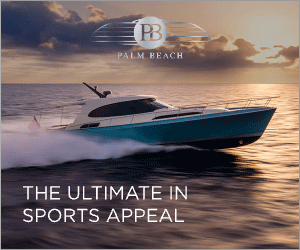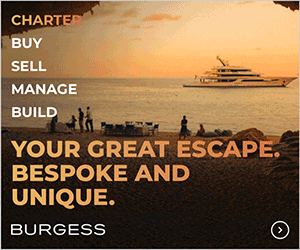Business as usual
As he readies his bags for another trip to Australia, Chief Executive at brokerage house Burgess Jonathan Beckett shares his views on the global market, the Australian superyacht industry and the future of yachting.
10 May 2023
The market has been hot for yachts and boats of all sizes since late 2020, but many predicted the COVID bounce would be short-lived and that other factors – including cost-of-living crises, rising energy bills and the ongoing war in Ukraine – might dampen the market.
Ocean caught up with Jonathan Beckett, a long-time lover of the Australian yachting scene, on his travels through Europe to ask some pertinent questions about where the market is headed and what the Australian industry could be doing better to encourage foreign visitors.
How did 2022 stack up for Burgess, and how’s 2023 looking?
We had an exceptional 2021 and thought that was almost unrepeatable, especially with the war in Ukraine, but 2022 proved to be a real stormer. We far exceeded our expectations, and it was our best year ever.
Australia was very strong for us, and the US too – America is the big driver in our market and was particularly strong last year. The Middle East was busy, and we sold to Brits and Europeans. It was a real mixed bag, actually. We’ve started 2023 well with four or five boats sold in January.
The difficulty is that at the end of the year, you wipe the slate clean and have to start again – to sell a big yacht is fantastic, but to do it over and over again takes a lot of determination, perseverance and steel.
Burgess has several service offerings in technical, legal, crew and other areas – what are your plans for the future?
Our strategy is to grow our ancillary services. We’re doing very well with Burgess Technical Services and our insurance and crew offerings, but there’s great potential to grow the ancillary side of the business. We’re also very strong with our brokerage and charter around the world, but we’re probably less well known in some countries than we should be for our services.
We’ve got all sorts of good ideas on that front, but the problem is we’re so busy with our day jobs that turning those ideas into reality is quite challenging! Still, we’re determined to make time to grow the business in areas with a steady income – that’s very important.
You used to spend much of your time travelling to meet clients – has that changed post-pandemic, and are boat shows a thing of the past?
The way I do business is by meeting people, getting in front of them and really telling them about our business and our services, and selling ourselves as people. There has been a slowdown in travel within Burgess, and we ask everyone in the company to consider whether it’s necessary to travel for a meeting or if it can be done via video call.
Video is great if you’ve already got a relationship with someone or you’re doing a monthly shipyard progress meeting, for example. We’re thinking of the environment and the expense – video calls cut wasted time, and they’re more cost-efficient. However, sometimes there’s no substitute for sitting in front of a client, designer or shipyard, whoever it may be, and having a face-to-face with them – it’s going to be a long time before video calls can replace that.
Boat shows are back on a sensible budget, although I don’t know if all of them are needed and I think we’ll see some fall away. Of course, we’re not talking about the Monaco Yacht Show, but you have Miami in February and then Palm Beach in March – you don’t need two shows an hour away and a month apart. We’ve trimmed our budgets for shows substantially and will try and stick to that.
You’ve visited Australia and the region many times. What are your views on our superyacht sector?
I’m a big supporter of Australia, as well as Australian owners and the industry in general. Most of our business, however, is selling, operating and chartering superyachts to Australians or for Australians. Generally, the yachts and charters are in Europe or the Caribbean, but we do have some boats in Australia. The boats there are getting bigger – that’s a great thing. We’re definitely supportive of the Australian industry.
Still, I would suggest you think about the industry Down Under, how it works and what it is people will want if you’re going to encourage more yachts and clients to head there – and that’s not just yachting; it’s the whole Australian experience.
It’s a long way for East Coast Americans and Europeans to come, and although they will do long-haul flights, it’s a long way for the children or grandchildren, and a long way from their businesses. Some people will come, and some won’t. In my view, the thing to do would be to concentrate on the US West Coast – it’s a very big market, and it’s younger and more adventurous than the traditional East Coast or European markets.
We’d be happy to help establish a presence on the US West Coast promoting yachting in Australia, but also yachting as part of a whole Australian experience. Or even a Fiji–New Zealand– Australia experience, of which yachts might be only a part – that would go down extremely well and help grow business.
How is the Asian market developing, and will yachting get more of a foothold there?
We have a big presence in Asia, in Singapore and in Hong Kong and India. We’ve done very well over the years, and have sold some great boats into those markets, so there’s a lot of potential but they’ve mainly been one-off deals or charters. It’s not like the US or European market. I doubt it will come in one or two years, but it might in five years, or more likely seven. But it’s definitely one to watch because when the gates open, there will be a flood of Asian clients coming into the market.
Do you think the next generation has a different view on wealth and humanity, and how will that impact the superyacht industry?
There’s obviously a considerable awareness of environmental issues, but it’s all relative. I don’t know how many more 150- or 160-metre yachts are going to get built, but a lot of our clients, who are very wealthy, do a lot for the environment and humanitarian situations. They donate huge amounts to charities and organisations, more so than many other people in terms of percentages, so I don’t think you can begrudge them some pleasure along with their wealth.
The 30- to 40-metre yacht segment is seeing a resurgence with models that offer all the mod cons of much larger yachts in terms of amenities, capability and space – what’s your prediction for yacht trends?
For the younger generation, those yachts are more affordable – they don’t want to buy a house in the Hamptons or have a Rolls-Royce Phantom with a driver; they want a cool loft apartment in downtown New York. And, with the 35- to 40-metre yachts, it’s not like it was 25 years ago when they were little boats with small spaces on board – now they’re big yachts with big spaces and big windows and lots of deck space. They’re pretty cool machines, and that will attract a lot of young people.
When are you next planning to visit Australia?
I’ll be there in April 2023. I’m looking forward to it. I go two or three times a year – we have a lot of clients in Australia, and I’m usually there for two weeks at a time, with breakfast, lunch and dinner meetings plus coffee meetings in the morning and customer meetings in the afternoon. I probably see 30 clients each trip – it’s like I live there because we often meet up for lunch or dinner, which is what I do with my clients in London. Not many people make it to Australia, so everyone is always really pleased to see you – they welcome you with open arms! It’s terrific, it really is a wonderful thing, and coming to Australia has been and continues to be one of the highlights of my career.









